DDS(Data Distribution Service)是一套通信协议和 API 标准;它提供了以数据为中心的连接服务,基于发布者-
订阅者模型。这是一套中间件,它提供介于操作系统和应用程序之间的功能,使得组件之间可以互相通信。并且提供了低延迟,高可靠的通信以及可扩展的架构。
DDS本身是一套标准。由Object Management Group(简称OMG)维护。OMG是一个开放性的非营利技术标准联盟,由许多大型IT公司组成:包括IBM,Apple Computer,Sun
Microsystems等。但OMG仅仅负责制定标准,而标准的实现则由其他服务提供商完成。目前DDS的提供商有很多:[Vortex
OpenSplice](https://www.adlinktech.com/en/vortex-opensplice-data-distribution-
service.aspx “Vortex OpenSplice”),eProsima Fast
RTPS,Hamersham,Company Summary
Kongsberg Gallium,MilSOFT,Object Computing
OpenDDS,Remedy IT,RTI,Twin Oaks Computing,
Inc.。
DDS 在网络栈中的位置

这个图之所以是沙漏形状是因为:两头的技术变化都发展很快,但是中间的却鲜有变化。
DDS 如何降低系统复杂度
-
传统分布式系统采用点对点的方案,会面临通道数量爆炸式增长问题:

-
而采用 DDS,拥有统一的 DDS DataBus,随着新节点的加入,不会增加拓扑的复杂度;

-
采用基于 DDS 的上层应用,能极大简化复杂度;

FastDDS
eProsima Fast DDS 目前已经被选为 Robot Operating System 2 (ROS
2)
系统的默认中间件并且被包含在最新发布版本Foxy Fitzroy中。
特性
- 两个 API 层:包含专注可用性的 上层DDS层,以及聚焦通道的底层RTPS层;
- 实时性(即插即连):提供实时特性,无论是发现,上线,下线,发送消息都能实时响应,并支持随时入网/出网;
- 同步/异步的数据发送模式;
- 可靠通信:即使在UDP通道上,也可支持可靠的通信范式;此外,也可以采用 TCP 通道;
- 传输层:UDPv4, UDPv6, TCPv4, TCPv6, SHM;
- 安全:可配置的安全通信,实现3个方面的安全配置:远程校验,访问控制,数据加密;
- 灵活性&拓展性:DDS 建立在全局数据空间的概率上,有良好的灵活性以及拓展性;
- 可移植性:通用的 RTPC 协议支持各 DDS 实现的互通,同时也支持写一遍代码运行于多个平台;
- 可配置:可以通过代码或者 XML 文件进行配置;
- 高性能:采用 FastCDR 作为序列化库;
- 统计模块
- 流量控制
- 免费开源
架构
如下图所示,FastDDS 大致可分为4层:
-
应用层 :提供用户友好的 API
-
FastDDS 层
1. 以数据为中心的模型,虚拟出**全局数据空间** 的概念,各节点向该空间声明**发布者** 或者**订阅者** 的意图;
1. 抽象出 Domain 以及 Topic 的概念,不同 Domain 之间数据独立不互通,在同一个 Domain 之间通过 Topic 发布/订阅数据;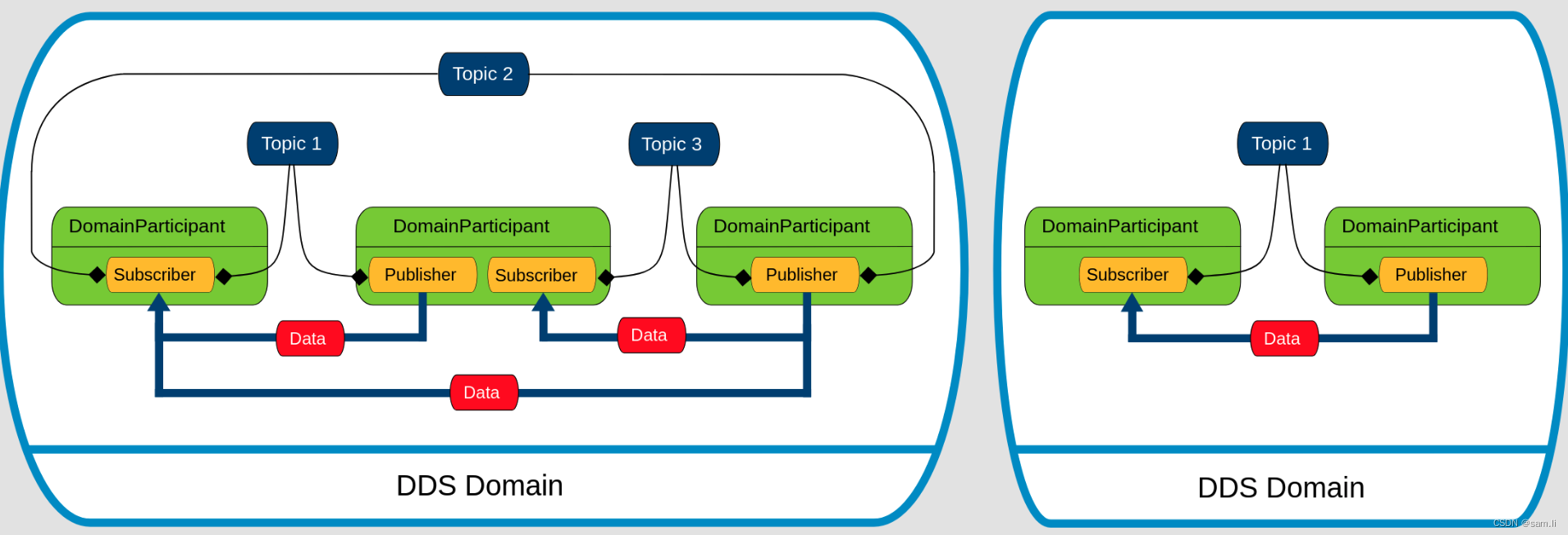
- RTPS 层 (作为通道层的抽象)
1. 由 OMG 联盟定义和维护,以确保不同 DDS 供应商应用程序之间可以互通;
2. 基于 TCP/UDP/IP 等传输协议,提供订阅/发布通道;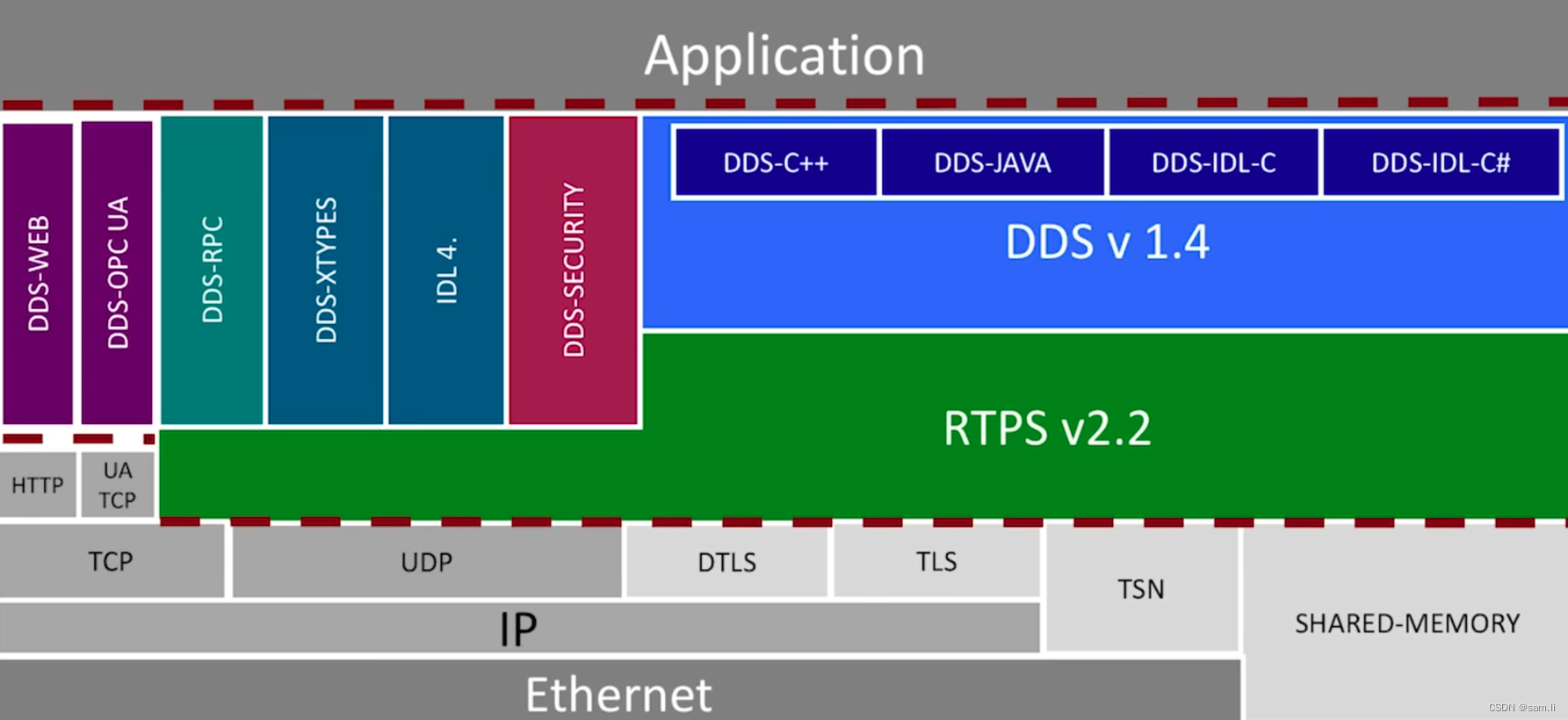
- 通道层

DDS
Entity
-
在 DDS 中,Entity 是一个抽象基类,表示支持 Qos 策略,listener 以及 状态的实体,它有许多实现:

-
不同的 Entity 实现有不同的回调,可以从回调中看到各实体的能力:

Domain
-
一个 Domain 相当于一个独立的数据交互平台,可以看作是虚拟网络;实现多个独立的应用在同一套物理网络中共存。可以类比于 VPS(虚拟机),同一台主机上的多个 VPS 共用硬件设备,但各 VPS 之间是独立的;
-
每个 Domain 都有独立的 domainId,只有 domainId 相同的应用才能互相通信;
-
Domain 在 FastDDS 中,使用 DomainParticipant 来管理;

[Partitions](https://fast-
dds.docs.eprosima.com/en/v2.6.0/fastdds/dds_layer/domain/domainParticipant/partition.html#partitions
“Partitions”)
- Partitions 是在 Domain 中引入的逻辑隔离,可以作用在 PublisherQos 和 SubscriberQos 上,定义了 Partitions 后,在订阅匹配上不仅要求 Topic 匹配,还要求 Partitions 匹配;
- 如果没有定义 Partitions,会自动包含在默认分区中;
- 每个 Entity(Publisher/Subscriber) 可以在多个 Partitions 中;
- Partitions 名支持通配符;看匹配示例;
[Publisher](https://fast-
dds.docs.eprosima.com/en/v2.6.0/fastdds/dds_layer/publisher/publisher.html#publisher
“Publisher”)
一个 Domain 可以创建多个 Publisher,每个 Publisher 可以创建多个 DataWriter,而一个 DataWriter
只能绑定一个 Topic

Topic
Topic 是作为订阅/发布模式的最基本的单位;
-
Publisher/Subscriber 于 Topic 都是一对一的关系;

-
在 Topic 中,还有更细分的 Instance 概念,查看 RTI 介绍的 什么是 DDS Samples, Instances, and Keys
1. 什么是 _instance_ :
1. 什么是 _key_ :在 IDL 文件中,可以定义当前数据的 key(和数据库有点像),比如:
struct HelloWorld
{
// Unique ID: airline name
@key string<256> airline_name;
// Unique ID: flight number
@key short flight_number;
// Coordinates
double latitude;
double longitude;
double altitude;
};
2. 什么是 _sample_ :在 DDS 中流通的每条数据都是一个 _sample_ ;
3. _instance_ :对定义过 _key_ 的 _sample_ 集合可以统一独立管理,这就是 _instance_ ;
2. _instance_ 在数据流中的示例:
3. _instance_ 的使用,查看 RTI 介绍的 [Managing Data Instances](https://community.rti.com/static/documentation/connext-dds/5.2.3/doc/manuals/connext_dds/html_files/RTI_ConnextDDS_CoreLibraries_UsersManual/Content/UsersManual/Managing_Data_Instances__Working_with_Ke.htm#sending_2410472787_2040704 "Managing Data Instances");
1. `register_instance()`:会返回 `InstanceHandle_t`,用来管理 _instance_ ;
2. `unregister_instance()`
3. `write()`
4. `dispose()`
4. _instance_ 生命周期:
5. 为什么要用 _instance_ :在往某个 _topic_ 发送数据的时候,DDS 会检查该数据属于哪个 _instance_ ;指定 _instance_ 可以提高性能,节约内存;
[Qos](https://fast-
dds.docs.eprosima.com/en/v2.6.0/fastdds/dds_layer/core/policy/policy.html
“Qos”)
Qos 基本上负责了 DDS 的所有配置,无论是心跳,消息可靠性,流量控制,还是安全配置,甚至包括通道配置,全是通过 Qos 来实现的。
[](https://fast-
dds.docs.eprosima.com/en/v2.6.0/fastdds/dds_layer/core/policy/standardQosPolicies.html#durabilityqospolicy
“DurabilityQosPolicy”)
配置新加入节点对已发送数据的接受规则;
- VOLATILE_DURABILITY_QOS :不保留已发送数据;
- TRANSIENT_LOCAL_DURABILITY_QOS :保留已发送数据,当有新 DataReader 加入,会把内存中的历史数据全部发给它;
- TRANSIENT_DURABILITY_QOS :在上述基础上,持久化到本地,这样就不会丢数据了;
[ReliabilityQosPolicy](https://fast-
dds.docs.eprosima.com/en/v2.6.0/fastdds/dds_layer/core/policy/standardQosPolicies.html#reliabilityqospolicy
“ReliabilityQosPolicy”)
配置通道的可靠性;
-
BEST_EFFORT_RELIABILITY_QOS :尽力而为,不保证数据可靠性;适合视频流等数据;
-
RELIABLE_RELIABILITY_QOS :保证可靠性;会等待 remote 的到达确认,如果数据丢失会重传;
-
max_block_time :当发送队列由于“未确认消息”而满的时候,DataWriter 的
write()操作可能会阻塞,这里设置最长阻塞时长,超时会报写入错误; -
DataWriter 和 DataReader 的 QOS 需要配对使用,如下:
-
| DataWriter kind | DataReader kind | Compatibility |
|---|---|---|
| BEST_EFFORT_RELIABILITY_QOS | BEST_EFFORT_RELIABILITY_QOS | Yes |
| BEST_EFFORT_RELIABILITY_QOS | RELIABLE_RELIABILITY_QOS | No |
| RELIABLE_RELIABILITY_QOS | BEST_EFFORT_RELIABILITY_QOS | Yes |
| RELIABLE_RELIABILITY_QOS | RELIABLE_RELIABILITY_QOS | Yes |
[HistoryQosPolicy](https://fast-
dds.docs.eprosima.com/en/v2.6.0/fastdds/dds_layer/core/policy/standardQosPolicies.html#historyqospolicy
“HistoryQosPolicy”)
配置已发送数据的缓存规则;
该策略行为会受到 ResourceLimitsQosPolicy 配置的影响;
-
KEEP_LAST_HISTORY_QOS :保留最新 depth 条数据; depth 需满足:
depth < ResourceLimitsQosPolicy.max_samples_per_instance
-
KEEP_ALL_HISTORY_QOS :保留所有历史数据;如果资源受限,后续行为会受 ReliabilityQosPolicy 的影响;
[ResourceLimitsQosPolicy](https://fast-
dds.docs.eprosima.com/en/v2.6.0/fastdds/dds_layer/core/policy/standardQosPolicies.html#resourcelimitsqospolicy
“ResourceLimitsQosPolicy”)
配置终端对某个 Topic 的资源限制;
| 参数 | 说明 |
|---|---|
| max_samples | 最大 sample 数 |
| max_instances | 最大 instance 数量 |
| max_samples_per_instance | 每个 instance 可以管理的最大 sample 数 |
| allocated_samples | 初始 sample 数 |
| extra_samples | 缓存池中额外 smaple 数;因此缓存池最大数量为 max_samples + extra_sample |
[LifespanQosPolicy](https://fast-
dds.docs.eprosima.com/en/v2.6.0/fastdds/dds_layer/core/policy/standardQosPolicies.html#lifespanqospolicy
“LifespanQosPolicy”)
数据的生命周期(过期时间),默认不过期;
过期的数据 DataWriter 就不会再投递,并且从DataWriter/DataReader 的 history 中清除;
[LivelinessQosPolicy](https://fast-
dds.docs.eprosima.com/en/v2.6.0/fastdds/dds_layer/core/policy/standardQosPolicies.html#livelinessqospolicy
“LivelinessQosPolicy”)
配置超时策略
- kind
1. AUTOMATIC_LIVELINESS_QOS :只要连接存在,就认为存活;
2. MANUAL_BY_PARTICIPANT_LIVELINESS_QOS :只要 remote DomainParticipant 响应,就认为存活;
3. MANUAL_BY_TOPIC_LIVELINESS_QOS :需要 remote 对应 Topic 响应,才认为存活; - lease_duration :超时时间,超过这个时间没有收到心跳包,则认为超时;
- announcement_period :只有 kind 为 上述 1或者2才会生效,表示发送心跳包之间的时间间隔;
[DeadlineQosPolicy](https://fast-
dds.docs.eprosima.com/en/v2.6.0/fastdds/dds_layer/core/policy/standardQosPolicies.html#deadlineqospolicy
“DeadlineQosPolicy”)
指定消息的更新频率,当新消息的频率降至某个阈值以下时,会发出警报。这对于需要定期更新数据的场景很有用
[DestinationOrderQosPolicy](https://fast-
dds.docs.eprosima.com/en/v2.6.0/fastdds/dds_layer/core/policy/standardQosPolicies.html#destinationorderqospolicy
“DestinationOrderQosPolicy”)
当多个 DataWriter 对同一个 Topic 发送相同 key 消息的时候,需要定义接收端的排序方式
- BY_RECEPTION_TIMESTAMP_DESTINATIONORDER_QOS :按接收端接收时间排序,可能会导致不同终端数据因为接收顺序不一致而导致数据的不一致;
- BY_SOURCE_TIMESTAMP_DESTINATIONORDER_QOS :按发送端的发送时间戳排序,可以保证多终端数据的一致性;
[OwnershipQosPolicy](https://fast-
dds.docs.eprosima.com/en/v2.6.0/fastdds/dds_layer/core/policy/standardQosPolicies.html#ownershipqospolicy
“OwnershipQosPolicy”)
对某个 Instance 配置是否允许多端同时下发;
- SHARED_OWNERSHIP_QOS :允许多终端同时下发;
- EXCLUSIVE_OWNERSHIP_QOS :不允许多终端同时下发,在某个时间点,只允许一个终端下发数据;而允许下发的终端是可动态变化的;
[PartitionQosPolicy](https://fast-
dds.docs.eprosima.com/en/v2.6.0/fastdds/dds_layer/core/policy/standardQosPolicies.html#partitionqospolicy
“PartitionQosPolicy”)
Partitions 是在 Domain 中引入的逻辑隔离;可以作用在 PublisherQos 和 SubscriberQos 上;
PartitionQosPolicy partitions;
//The PartitionsQosPolicy is default constructed with max_size = 0.
//Max_size is a private member so you need to use getters and setters to access
//Change the max_size to 20
partitions.set_max_size(20); //Setter function
//The PartitionsQosPolicy is default constructed with an empty list of partitions
//Partitions is a private member so you need to use getters and setters to access
//Add new partitions
std::vector<std::string> part = partitions.names();
part.push_back("part1");
part.push_back("part2");
partitions.names(part); //Setter function
[FlowControllersQos](https://fast-
dds.docs.eprosima.com/en/v2.6.0/fastdds/dds_layer/core/policy/eprosimaExtensions.html#flowcontrollersqos
“FlowControllersQos”)
流量控制
- scheduler :
1. _FIFO_ :先 write,先发送;
2. _ROUND_ROBIN_ :循环所有 DataWriter,每次只发一条 sample;
3. _HIGH_PRIORITY_ :根据优先级,高优先级优先发送;
4. _PRIORITY_WITH_RESERVATION_ :在上述 _HIGH_PRIORITY_ 的基础上,预留一定的带宽资源给当前 DataWritter 使用;
-
max_bytes_per_period :单位 period_ms 时间内,最大能发送的数据量(bytes);
-
period_ms :时长,单位 milliseconds;
-
Example:
// Limit to 300kb per second.
static const char* flow_controller_name = “example_flow_controller”;
auto flow_control_300k_per_sec = std::make_sharedeprosima::fastdds::rtps::FlowControllerDescriptor();
flow_control_300k_per_sec->name = flow_controller_name;
flow_control_300k_per_sec->scheduler = eprosima::fastdds::rtps::FlowControllerSchedulerPolicy::FIFO;
flow_control_300k_per_sec->max_bytes_per_period = 300 * 1000;
flow_control_300k_per_sec->period_ms = 1000;
// Register flow controller on participant
DomainParticipantQos participant_qos;
participant_qos.flow_controllers().push_back(flow_control_300k_per_sec);
// .... create participant and publisher
// Link writer to the registered flow controller.
// Note that ASYNCHRONOUS_PUBLISH_MODE must be used
DataWriterQos qos;
qos.publish_mode().kind = ASYNCHRONOUS_PUBLISH_MODE;
qos.publish_mode().flow_controller_name = flow_controller_name;
[PublishModeQosPolicy](https://fast-
dds.docs.eprosima.com/en/v2.3.0/fastdds/dds_layer/core/policy/eprosimaExtensions.html#publishmodeqospolicy
“PublishModeQosPolicy”)
- SYNCHRONOUS_PUBLISH_MODE :同步发送数据;
- ASYNCHRONOUS_PUBLISH_MODE :异步发送数据;
发现协议
发现机制
| 发现机制 | 简介 |
|---|---|
| [Simple Discovery](https://fast- | |
| dds.docs.eprosima.com/en/v2.6.0/fastdds/discovery/simple.html "Simple | |
| Discovery") (默认) | 分为 SPDP、SEDP 两个阶段 |
| [Discovery Server](https://fast- | |
| dds.docs.eprosima.com/en/latest/fastdds/discovery/discovery_server.html# | |
| “Discovery Server”) | 集中式发现体系结构 |
| [Static Discovery](https://fast- | |
| dds.docs.eprosima.com/en/latest/fastdds/discovery/static.html "Static | |
| Discovery") | 使用 SPDP,而 EDP 需要手工(XML)配置 |
| Manual Discovery | 位于 RTPS 层,全手动配置 |
Discovery Server 和 Simple Discovery 的比较: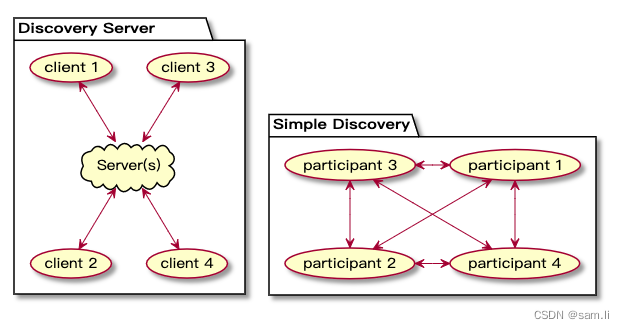
发现步骤([SIMPLE](https://fast-
dds.docs.eprosima.com/en/latest/fastdds/discovery/simple.html “SIMPLE”))

- 向指定的多播地址(默认 239.255.0.1)发送本机 DomainParticipants 信息,主要包含下图中的 DomainId,单播地址等;

这个信息会循环发送
1. 在 DomainParticipants 创建期间,默认以 100ms 间隔持续发送,可以通过 `discovery_config.initial_announcements.period`设置;
2. Participants 创建完毕后,默认会以 3秒 的间隔持续发送;可通过`discovery_config.leaseDuration_announcementperiod`设置;
-
加入多播组(239.255.0.1),以接受多播消息;
-
按照 RTPS 标准,每个 Participant 需要监听 2个端口;当然,端口号可以并存预设,以及计算规则的修改;
1. 单播端口:`unicast_port = 7400 + 250 * domainID + 10 + 2 * participantID`;
2. 多播端口:`multicast_port = 7400 + 250 * domainId + 0`
这里设计巧妙的一点,不同 domainID 使用的多播端口号是不同的,所以不同 domain 之间数据是隔离的(不会互相发现);而且相同 domain
不同终端之间计算出来的多播端口号是一致的,所以可以直接找到对方而不用过滤;
- 总体Simple Discovery机制的发现步骤如下,其中多播并不是必要的,如果初始化的时候可以内置单播地址以及端口,就可以禁用多播通道;

超时
默认 20 秒,可以通过discovery_config.leaseDuration 配置;
通道层
默认通道
FastDDS 默认开启 UDP & SHM 通道,可以设置 use_builtin_transports = false关闭;
[UDP 通道](https://fast-
dds.docs.eprosima.com/en/latest/fastdds/transport/udp/udp.html “UDP 通道”)
DomainParticipantQos qos;
// Create a descriptor for the new transport.
auto udp_transport = std::make_shared<UDPv4TransportDescriptor>();
udp_transport->sendBufferSize = 9216;
udp_transport->receiveBufferSize = 9216;
udp_transport->non_blocking_send = true;
// Link the Transport Layer to the Participant.
qos.transport().user_transports.push_back(udp_transport);
// Avoid using the default transport
qos.transport().use_builtin_transports = false;
[TCP 通道](https://fast-
dds.docs.eprosima.com/en/latest/fastdds/transport/tcp/tcp.html “TCP 通道”)
TCP 通道可以实现广域网中 DDS 的使用,区分客户端以及服务端,不同的端需要不同配置;
-
服务端配置
DomainParticipantQos qos;
// Create a descriptor for the new transport.
auto tcp_transport = std::make_shared<TCPv4TransportDescriptor>();
tcp_transport->sendBufferSize = 9216;
tcp_transport->receiveBufferSize = 9216;
tcp_transport->add_listener_port(5100);
tcp_transport->set_WAN_address("80.80.99.45");
// Link the Transport Layer to the Participant.
qos.transport().user_transports.push_back(tcp_transport);
// Avoid using the default transport
qos.transport().use_builtin_transports = false;
-
客户端配置:
DomainParticipantQos qos;
// Disable the built-in Transport Layer.
qos.transport().use_builtin_transports = false;
// Create a descriptor for the new transport.
// Do not configure any listener port
auto tcp_transport = std::make_shared<TCPv4TransportDescriptor>();
qos.transport().user_transports.push_back(tcp_transport);
// Set initial peers.
Locator_t initial_peer_locator;
initial_peer_locator.kind = LOCATOR_KIND_TCPv4;
IPLocator::setIPv4(initial_peer_locator, "80.80.99.45");
initial_peer_locator.port = 5100;
qos.wire_protocol().builtin.initialPeersList.push_back(initial_peer_locator);
// Avoid using the default transport
qos.transport().use_builtin_transports = false;
- 经过测试,在同一个 Domain 中开启 TCP 以及 UDP 通道,只会有一个通道生效(前一个),这2个并不能共存;所以如果需要通过云端将多个局域网连接在一起,需要使用独立的 TCP Domain 作为隧道打通局域网;
安全
FastDDS 提供5个安全构建时插件,分别是 身份鉴定,访问控制,数据加密,日志,数据标签;

[身份鉴定](https://fast-
dds.docs.eprosima.com/en/v2.6.0/fastdds/security/auth_plugin/auth_plugin.html
“身份鉴定”)
- 需要用到的几个证书
| 证书配置 | 说明 |
|---|---|
| identity_ca | DDS 使用的根证书,所有 DDS 客户端共用一份;本证书私钥需要管理员自行保存; |
| identity_certificate | DomainParticipant 使用的证书,需要被 identity_ca |
| (根证书)签名,各终端互相独立; | |
| identity_crl (可选) | 过期的证书列表 |
| private_key | DomainParticipant 证书私钥,对应上述 identity_certificate |
| 证书;需要配置到终端中; | |
| password (可选) | 私钥密码,可以将上述 private_key 加密,这里传入密码; |
- 初始化证书
1. 根证书( _identity_ca_ ):可以内置,或者在终端首次运行时从服务端获取;用来在**发现期间** 验证其他 DomainParticipant 证书合法性;
2. DomainParticipant 证书( _identity_certificate_ ):在终端首次运行时自动生成,本地保存好私钥;然后将生成的证书上传服务器请求签名,服务器使用根证书签名后返回;后续 DomainParticipant 就可以使用这个证书进行发现服务的身份鉴定;
sequenceDiagram
participant C as Client
participant S as 证书服务器
C->>C: 首次运行,生成“私钥A”及“CA证书A”(identity_certificate)
Note over C: 将“私钥A”储存<br>于安全区域
C->>S: 将“CA证书A”上传至证书服务器
S->>S: 使用根证书私钥签名“CA证书A”,得到“CA证书B”
S->>C: 返回“CA证书B”
C->>C: 保存“CA证书B”(没有安全要求)
- 身份鉴定
1. DomainParticipant 初始化: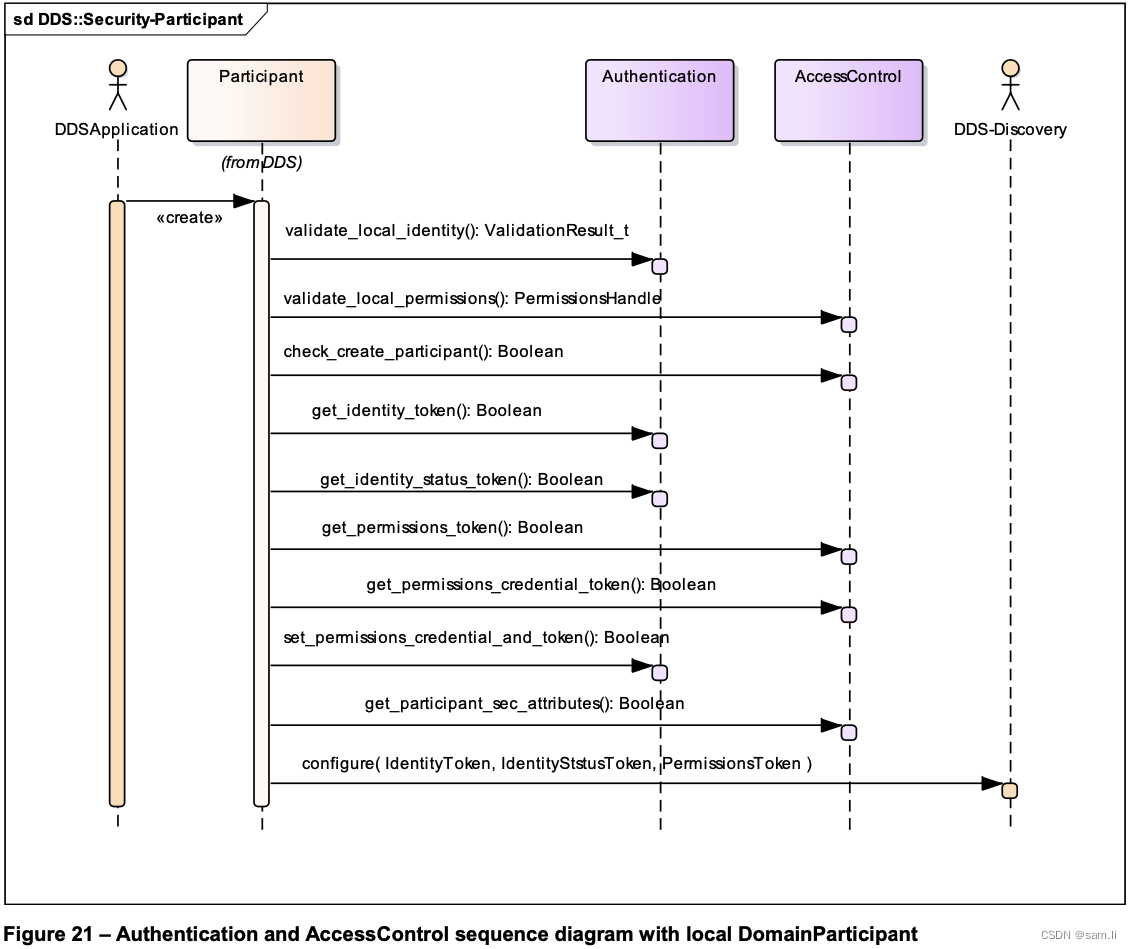
1. 在调用 `create_participant` 方法创建 DomainParticipant 的时候,会进入自检流程,自检完成会生成 `IdentityToken`,`PermissionsToken` 等,然后交给发现服务使用;
2. `validate_local_identity()` `(#70,#192)`:
1. 使用根证书,验证本地 DomainParticipant 的 _identity_certificate_ 证书合法性;
2. 该方法需要返回当前 participant 的句柄`IdentityHandle`,以及在 DDS 网络中唯一的身份标识`GUID_t`;
2. 进入握手环节: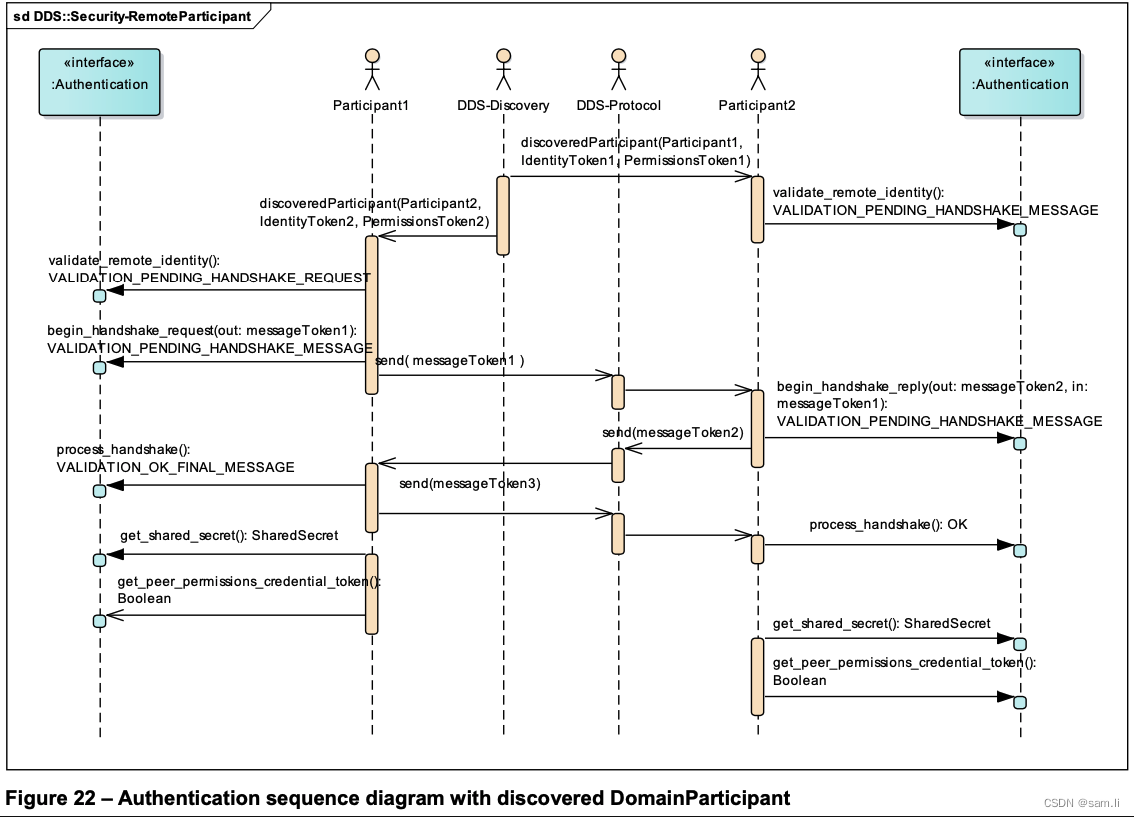
1. `validate_remote_identity()` `(#193)`:
1. 验证 `remote_identity_token` 和 `local_identity_token` 是否一致;
2. 比较 `participant_guid`
if (remote_participant_guid > local_participant_guid)
return VALIDATION_PENDING_HANDSHAKE_REQUEST; // 下一步:begin_handshake_request
else
return VALIDATION_PENDING_HANDSHAKE_MESSAGE; // 下一步:等待
2. `HandShakeMessageToken`有3种格式 `(#187)`:
1. `HandShakeRequestMessageToken`( [table 49](https://gitbook.tuya-inc.top:7799/cppthings/img/posts/dds/secure_discovery_handshakerequestmessagetoken.png "table 49") ) 关键结构:identity_certificate,permissions文件,dh1(publicKey),随机数 nonce;
2. `HandShakeReplyMessageToken`( [table 50](https://gitbook.tuya-inc.top:7799/cppthings/img/posts/dds/secure_discovery_handshakereplymessagetoken.png "table 50") ) :identity_certificate,permissions 文件,dh1,dh2,nonce
3. `HandShakeFinalMessageToken`( [table 51](https://gitbook.tuya-inc.top:7799/cppthings/img/posts/dds/secure_discovery_handshakefinalmessagetoken.png "table 51") ) :dh1,dh2,nonce1,nonce2
3. `begin_handshake_reply` `(#194)`:
1. 使用根证书验证 remote 证书 `HandShakeRequestMessageToken.c.id`;
2. 生成 dh1 = DH publicKey,生成随机数保留本地,然后将 dh1 发给 remote;
4. `begin_handshake_request.process_handshake`:
1. 使用根证书验证 remote 证书;
2. 生成随机数保留本地,计算 dh2 发给 remote;
3. 使用本地随机数,以及 dh1 生成共享对称密钥;
5. `begin_handshake_replay.process_handshake`: 使用本地随机数,以及 dh2 生成共享对称密钥;
6. `get_shared_secret()`:获得协商后的对称加密密钥;
-
终端配置
DomainParticipantQos pqos;
// 启用“身份鉴定”插件:
pqos.properties().properties().emplace_back(“dds.sec.auth.plugin”,
“builtin.PKI-DH”);
// 配置根证书:
pqos.properties().properties().emplace_back(
“dds.sec.auth.builtin.PKI-DH.identity_ca”,
“file://identity_ca.pem”);
// 配置终端证书:
pqos.properties().properties().emplace_back(
“dds.sec.auth.builtin.PKI-DH.identity_certificate”,
“file://identity_certificate.pem”);
// 终端证书私钥:
pqos.properties().properties().emplace_back(
“dds.sec.auth.builtin.PKI-DH.private_key”,
“file://private_key.pem”);
访问控制
- 需要用到的几个文件
| 配置 | 说明 |
|---|---|
| permissions_ca | 权限根证书(可以共用上面的 identity_ca |
| ),下面2个文件都需要被此证书[加签](https://fast- | |
| dds.docs.eprosima.com/en/v2.6.0/fastdds/security/access_control_plugin/access_control_plugin.html#signing- | |
| documents-using-x509-certificate “加签”) | |
| [governance](https://fast- | |
| dds.docs.eprosima.com/en/v2.6.0/fastdds/security/access_control_plugin/access_control_plugin.html#domain- | |
| governance-document “governance”) | 配置数据加密方式,加密等级等 |
| [permissions](https://fast- | |
| dds.docs.eprosima.com/en/v2.6.0/fastdds/security/access_control_plugin/access_control_plugin.html#domainparticipant- | |
| permissions-document “permissions”) | 访问权限配置 |
配置数据在 DDS 中的加密方式,加密等级,加密范围;
<dds xmlns:xsi="http://www.w3.org/2001/XMLSchema-instance"
2 xsi:noNamespaceSchemaLocation="omg_shared_ca_domain_governance.xsd">
3 <domain_access_rules>
4 <domain_rule>
5 <domains>
6 <id_range>
7 <min>0</min>
8 <max>230</max>
9 </id_range>
10 </domains>
11 <allow_unauthenticated_participants>false</allow_unauthenticated_participants>
12 <enable_join_access_control>true</enable_join_access_control>
13 <discovery_protection_kind>ENCRYPT</discovery_protection_kind>
14 <liveliness_protection_kind>ENCRYPT</liveliness_protection_kind>
15 <rtps_protection_kind>ENCRYPT</rtps_protection_kind>
16 <topic_access_rules>
17 <topic_rule>
18 <topic_expression>HelloWorldTopic</topic_expression>
19 <enable_discovery_protection>true</enable_discovery_protection>
20 <enable_liveliness_protection>false</enable_liveliness_protection>
21 <enable_read_access_control>true</enable_read_access_control>
22 <enable_write_access_control>true</enable_write_access_control>
23 <metadata_protection_kind>ENCRYPT</metadata_protection_kind>
24 <data_protection_kind>ENCRYPT</data_protection_kind>
25 </topic_rule>
26 </topic_access_rules>
27 </domain_rule>
28 </domain_access_rules>
29</dds>
对 DomainParticipant 的权限进行细分定制,包括当前 participant 对各 Topic 的“订阅权限”,“发送权限”;
<dds xmlns:xsi="http://www.w3.org/2001/XMLSchema-instance"
2 xsi:noNamespaceSchemaLocation="http://www.omg.org/xxx">
3 <permissions>
4 <grant name="PublisherPermissions">
5 <subject_name>emailAddress=xxx</subject_name>
6 <validity>
7 <not_before>2013-06-01T13:00:00</not_before>
8 <not_after>2038-06-01T13:00:00</not_after>
9 </validity>
10 <allow_rule>
11 <domains>
12 <id_range>
13 <min>0</min>
14 <max>230</max>
15 </id_range>
16 </domains>
17 <publish>
18 <topics>
19 <topic>HelloWorldTopic</topic>
20 </topics>
21 </publish>
22 </allow_rule>
23 <default>DENY</default>
24 </grant>
46 </permissions>
47</dds>
数据加密
- 提供的能力
提供加解密相关工具,封装加解密,Hash,密钥生成,签名验证等能力;默认使用 AES-GCM-128 加密方式,以及 GMAC 消息验证码;
本插件需要和“身份鉴定”以及“访问控制”插件配合使用;
-
配置
emplace_back(“dds.sec.crypto.plugin”, “builtin.AES-GCM-GMAC”);
安全日志
记录上述所有的涉及安全的事件日志,方便安全行为分析,以及错误分析;
| Level | Definition |
|---|---|
EMERGENCY_LEVEL | System is unusable. Should not continue use. |
ALERT_LEVEL | Should be corrected immediately. |
CRITICAL_LEVEL | A failure in primary application. |
ERROR_LEVEL | General error conditions. Default value. |
WARNING_LEVEL | May indicate future error if action not taken. |
NOTICE_LEVEL | Unusual, but nor erroneous event or condition. |
INFORMATIONAL_LEVEL | Normal operational. Requires no action. |
DEBUG_LEVEL | Normal operational. |
-
日志配置
DomainParticipantQos pqos;
pqos.properties().properties().emplace_back(“dds.sec.log.plugin”,
“builtin.DDS_LogTopic”);
pqos.properties().properties().emplace_back(
"dds.sec.log.builtin.DDS_LogTopic.logging_level",
"EMERGENCY_LEVEL");
pqos.properties().properties().emplace_back(
"dds.sec.log.builtin.DDS_LogTopic.log_file",
"myLogFile.log");
数据标签
[数据标签](https://fast-
dds.docs.eprosima.com/en/v2.6.0/fastdds/security/security.html “数据标签”)插件在
FastDDS 中还未实现,未来会有实现可用;
动态数据类型
[动态数据类型](https://fast-
dds.docs.eprosima.com/en/v2.6.0/fastdds/dynamic_types/dynamic_types.html
“动态数据类型”) 提供动态的方式定义 Topic 以及 TopicData,而不用提前定义 IDLs,对一些动态要求较高的场景下比较合适;
详细文档: Extensible and Dynamic Topic Types for
DDS
相关依赖
| 库 | 简介 |
|---|---|
| Asio | 用于网络和低级 I/O 编程的跨平台 C++ 库,它使用现代 |
| C++ 方法为开发人员提供一致的异步模型。 | |
| TinyXML2 | |
| 开源、简单、小巧、高效的C++ XML解析器,它只有一个.h文件和一个.cpp文件组成。 | |
| OpenSSL | |
| Foonathan memory | 内存分配器 |
| Fast CDR | FastDDS |
| 使用的高效序列化库; | |
| 性能比较: [Apache Thrift vs Protocol Buffers vs Fast | |
| Buffers](https://www.eprosima.com/index.php/resources-all/performance/apache- | |
| thrift-vs-protocol-buffers-vs-fast-buffers "Apache Thrift vs Protocol Buffers | |
| vs Fast Buffers") | |
| [Fast DDS-Gen](https://fast- | |
| dds.docs.eprosima.com/en/latest/fastddsgen/introduction/introduction.html | |
| “Fast DDS-Gen”) | 一个 Java 应用程序,它根据接口描述语言 (IDL) 文件中定义的数据类型自动生成 C++ 源代码。 |
参考
- DDS与FastRTPS
- Using DDS with TSN and Adaptive AUTOSAR
- Data Distribution Service™ (DDS™)
- ROS 2设计文章系列之十一——ROS 2与DDS-Security的集成
- 基于安全协商的DDS安全通信中间件设计
- 工业级数据分发服务DDS简介及安全特性分析
- OpenSSL生成根证书CA及签发子证书
- DDS Security v1.1
- IGMP
- IGMP基础原理与实验
学习计划安排

我一共划分了六个阶段,但并不是说你得学完全部才能上手工作,对于一些初级岗位,学到第三四个阶段就足矣~
这里我整合并且整理成了一份【282G】的网络安全从零基础入门到进阶资料包,需要的小伙伴可以扫描下方CSDN官方合作二维码免费领取哦,无偿分享!!!
如果你对网络安全入门感兴趣,那么你需要的话可以
点击这里👉网络安全重磅福利:入门&进阶全套282G学习资源包免费分享!
①网络安全学习路线
②上百份渗透测试电子书
③安全攻防357页笔记
④50份安全攻防面试指南
⑤安全红队渗透工具包
⑥HW护网行动经验总结
⑦100个漏洞实战案例
⑧安全大厂内部视频资源
⑨历年CTF夺旗赛题解析


























 4564
4564

 被折叠的 条评论
为什么被折叠?
被折叠的 条评论
为什么被折叠?








